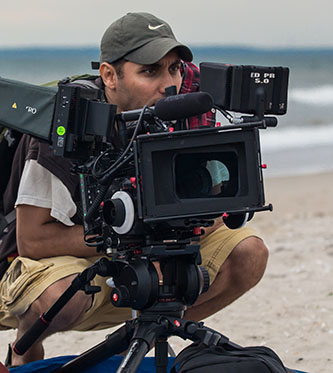Shachar Langlev '06 Wins Sundance Award
March 3, 2014

Shachar Langlev working on his new project, A Scientist's Guide to Living and Dying.
Capturing the Sundance 2014 Audience Award for the documentary Alive Inside: A story of Music & Memory is a milestone on a journey that began for its director Michael Rossato-Bennett and director of photography, Shachar Langlev '06, with a YouTube video. The documentary, which highlights the ongoing work of Dan Cohen, a social worker who uses iPods as therapeutic tools in nursing homes, reveals the healing power of music for Alzheimer and dementia patients.
"This is a story about how music brings back memories to people considered beyond hope," says Langlev, who graduated with a CUNY bachelor of science in film production and psychology, but did his film studies at Brooklyn College. "It restores some of their dignity. The Sundance crowd was really moved and voted us as favorites."
The film started as a project with funding from the Shelley & Donald Rubin Foundation. The founders of the Rubin Museum of Art in New York City had learned about Cohen's groundbreaking work and wanted to create a five-minute video about it for Cohen's website. Cohen had posed a simple question: If most people, young and old, own an iPod or an MP3 player, why can’t they be used on nursing home patients afflicted by those two devastating illnesses? This became the basis for the video.
The resulting 2009 short by Rossato-Bennett and Langlev featured Henry Dryer, a 94-year-old African-American patient who was deeply depressed and unresponsive to the world. When he listens on his iPod to music by his favorite singer Cab Calloway, Dryer opens his eyes and starts humming along, saying that he likes it because it is the music of love and the senses.
Over the next couple of years, the YouTube footage was viewed by more than 3,000 people who left positive comments. But after a viewer posted it on the website Reddit, the short went viral. Fifteen days later, it hit the four million-view mark.
"That convinced us that we needed to do something longer, a documentary," explains Langlev, so they started fundraising via Kickstarter and in other ways. "It took us two years to approach what we needed, but the money allowed us to do more research, visit more patients, get permission from relatives, and talk to specialists. We didn't know whether it would make money, but we realized we needed to tell this story."
Original YouTube segment of Alive Inside for Dan Cohen's Memory and Music Project.
Media outlets such as The New York Times, the Los Angeles Times, CNN, and NBC featured segments of the mini-documentary that had cropped up on YouTube that included other patients using music therapy.
"We wanted to create something special but we knew it required a unique approach and it wasn't easy," Langlev says, adding that the Sundance award should help them place the documentary in theaters and other commercial venues.
Langlev, who hails from Nahariya, Israel, has directed music videos for MTV, VH1 and the digital cable and satellite channel FUSE. He is now directing his first narrative feature film, A Scientist's Guide to Living and Dying, written by his wife, actress and screenwriter Nitzan Mager '08. His director of photography, Roy Nowlin, also studied at Brooklyn College.
"Shachar was easily one of most talented students to ever go through our film production program," says William Hornsby, associate professor at the Film Department, who mentored Langlev. "To paraphrase a line from the Indiewire piece, he knew how to 'focus way back then . . .' and has not forgotten how to stay that way."
"Professor Hornsby gave me the skills to become a cinematographer," Langlev says. "And [film] Professor Robert Tutak taught us how to direct. I hope I can teach like them at Brooklyn College one day and share what I learned from them and from my own experience," he says, adding, "Brooklyn College has the best and most affordable undergraduate film program in America, no question."






